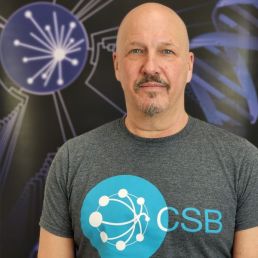CSB research technician Bob Strome recently received his pin for 35 years of service at UofT. Through decades of molecular biology research at UofT, he has been at the core of new technology development, seen old technologies sidelined, and has witnessed UofT buildings fall and rise.
Strome started in the Banting and Best Institute in 1988. He worked in the Krause lab on early development of the fruit fly embryo, focusing on the fushi terazu gene, also known as ftz. “We would label ftz DNA nucleotides with radioactive phosphate and write down the sequence in our lab book” notes Strome. “In 2024, we just put the DNA in a tube, send it for fluorescent sequencing and receive the data file.”
Starting in 1995, Strome began work on Alzheimer’s and prion diseases at the Tanz Centre for Research into Neurodegenerative Diseases (CRND). He was lab manager for the Westaway lab, which also allowed him to develop skills in people management.
Strome was part of a team that created mice which developed symptoms of Alzheimer’s disease. These models allowed researchers to develop treatments for human sufferers of Alzheimer’s. His genetic engineering skills were key, as every tool used to alter the mouse genome had to be the correct sequence, with no errors. By rigorous adherence to protocol, Strome ensured every transgenic generated would have no reason to go wrong.
Through this careful work, the CRND developed a mouse model that is still the world standard for Alzheimer’s studies. The CRND website notes (under Breakthroughs) that “This mouse is now being used by numerous academic and industrial researchers to investigate the mechanisms of nerve cell injury and the effects of potential new therapies.”
As lab manager, part of Strome’s job became transferring breeding pairs of these mice to academic labs and pharma companies that were developing Alzheimer’s treatments.
“One of the most meaningful parts of my work at CRND was hosting tours for donors to Alzheimer’s research.” Strome shares. “Many had loved ones that were affected by dementia, and we could show them their contributions were leading to progress in understanding and treating dementia.”
With funding cuts after the Great Recession, Strome’s job at CRND ended and he was hired to be lab manager for Cell & Systems Biology’s Moses lab in the Earth Science Building. The Moses lab uses AI models to study the evolution of cellular regulatory networks, and Strome validates those models in living systems.
People can stay for 35 years at the University, but the buildings often decay and fall. Strome started in the historic C.H. Best Building, a moldy brick structure with rusty pipes that has since been replaced by the Schwartz-Reisman Building.
During his Alzheimer’s work, Strome would take lunch breaks next door in the University’s desert and tropical greenhouses and made friends there with the University horticulturalists. However, these stone and ironwork greenhouses were eventually replaced by the Pharmacy Building.
When Strome moved into the Moses lab, he found out that the plants from the desert and tropical greenhouses were now located on the roof of the Earth Sciences Building. He became joyfully reacquainted with his old horticulturalist friends, and made new friends who share his passion for guitars. They sometimes play on the roof by the greenhouses, where they’ve added a drum kit.
Strome’s old work on neurodegenerative diseases is also coming back into play, as prion proteins that result in neurodegenerative diseases possess similar properties to the class of proteins being studied in The Moses Lab.
Congratulations on 35 years at UofT, Bob Strome!

